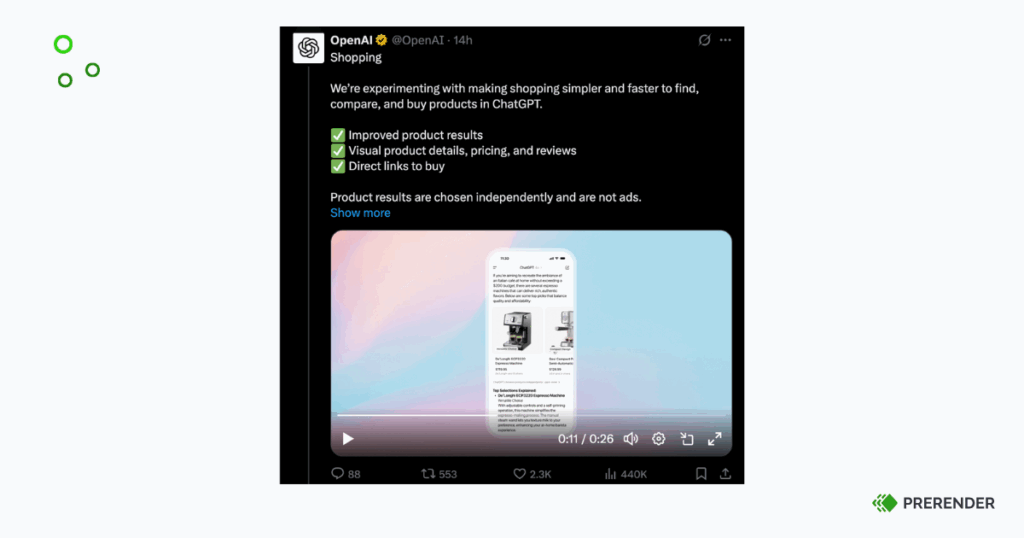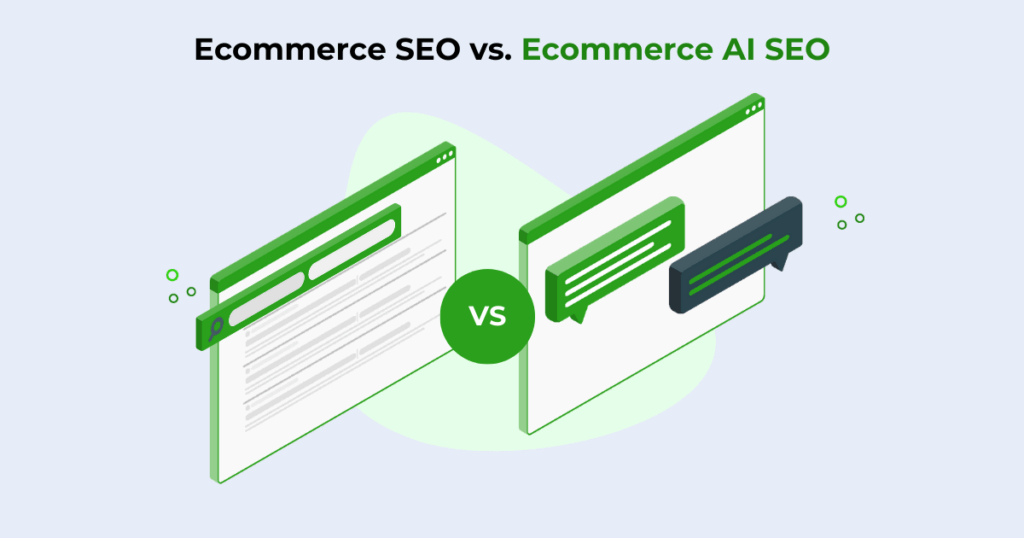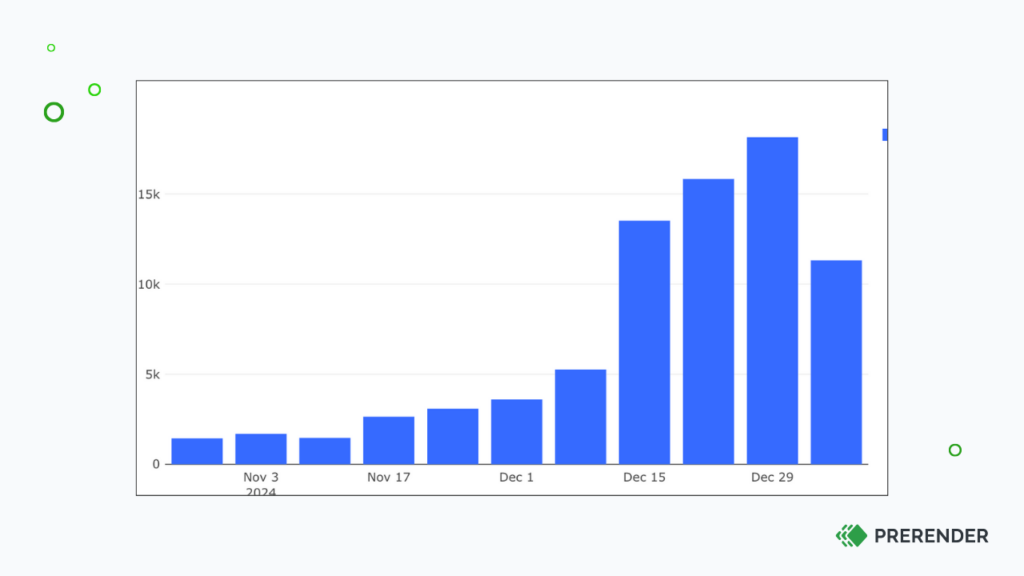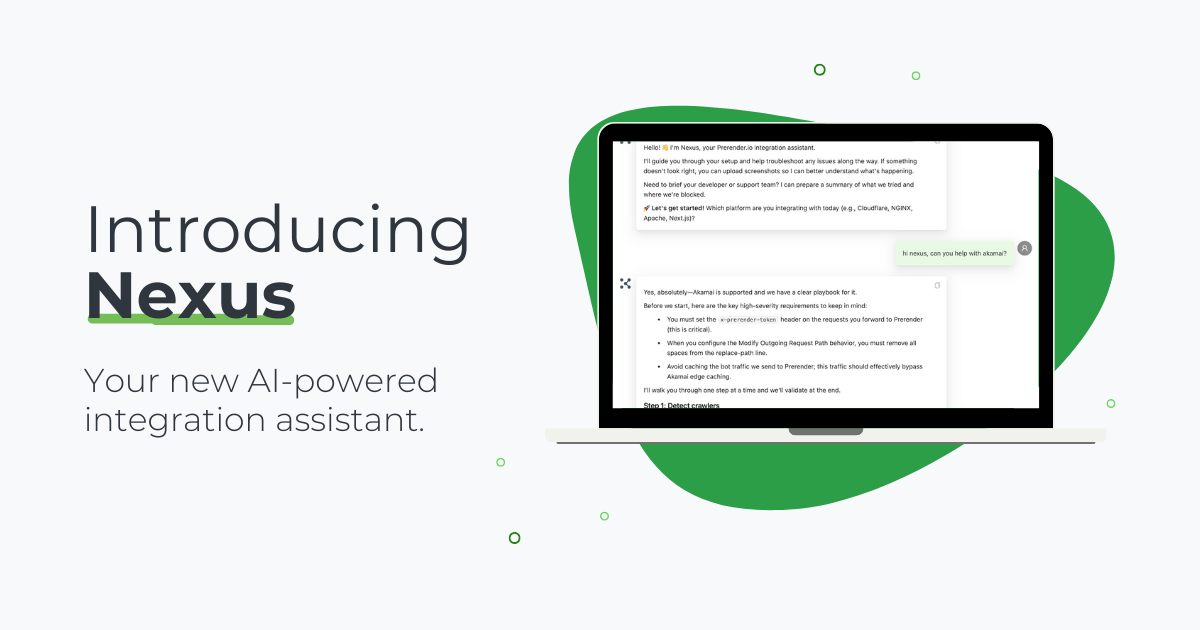Online shopping is changing—big time. Users are no longer exclusively relying on Google to search and shop online, and are opting for different search shopping channels, such as ChatGPT, DeepSeek, Perplexity, SearchGPT, Claude, and other AI-powered platforms.
Why You Should Optimize for AI SEO
It goes without saying that you need to optimize for AI SEO. But let’s do a quick refresher.
Currently, AI crawler traffic makes up about ~30% of Google’s market share—and this is only expected to grow.
A recent report by Adobe suggests that between November 1 and December 31, 2024, U.S. retail websites received a 1,300% increase in traffic from generative AI searches compared to the prior year. Compared to July 2024, the retail websites received 1,200% increased traffic from generative AI sources in February 2025, signifying a persistent trend beyond the holiday season.
This shift in consumer behavior and the notable growth of generative AI traffic, which has been doubling every two months since September 2024, as shown above, signifies the growing need for AI SEO optimization for retail and ecommerce websites. Here are additional stats:
- Users referred from AI search tend to stay on a website 8% longer, browse through different pages 12% more, and leave or bounce off the website 23% less likely compared to traditional source referrals.
- According to an Adobe survey, of 5,000 consumers, 39% use or have used generative AI for online shopping, 55% use it to conduct research, and 47% use it to receive product recommendations.
- AI-powered visual search is gaining immense popularity. Projections suggest that 30% of all online searches will be through visual search by 2025, especially with 48% of Gen Z and millennials preferring visual search over traditional search platforms.
- Statista reports that AI-driven personalized shopping experiences significantly improve customer retention, resulting in repeat purchases for 44% of businesses.
Is AI SEO Actually Different Than Traditional SEO?
This depends—there are a few narratives out there.
Some conversations think that AI SEO is just a trend, and that we shouldn’t have to adapt to it. But AI isn’t going anywhere, and in fact, it’s the opposite—AI search engines are growing exponentially. The number of weekly ChatGPT users has gone from 300M to 400M in just a matter of 2 months, and this number is expected to reach 1 billion by the end of 2025.
With visual and voice search, hyper-personalization, and enhanced search experiences, AI search is here to stay. That said, this doesn’t mean AI search will completely replace traditional search engines like Google. Instead, it will complement them by providing much more relevant information, natural and conversational interactions, and an enhanced user experience.
This is just one perspective. Another narrative is that that if you rank highly on Google or Bing, you’ll rank just as highly in ChatGPT and generative engines.
After all, even Ahrefs itself says that “LLMO, AEO, and GEO are all just SEO.” And yes, there’s certainly merit to this. In itself, the fundamentals behind ranking on each of these is essentially SEO.
However, one of the clearest differences between SEO and AI SEO—for now—is a user’s changing search behaviour on AI tools versus traditional search engines. Users on ChatGPT simply don’t search the same way that they do on Google, and this can have a big impact on purchasing decisions.
Related: How traditional search vs. AI-powered search differ.
How to Adapt to Ecommerce AI SEO: Online Shopping on Google vs. ChatGPT
So, how are users shopping on traditional search platforms vs. AI platforms?
A search query on Google looks vastly different from ChatGPT. And brands will have to adapt their SEO strategies for new updates and changing query styles, among other AI SEO optimization best practices.
For example, here’s how a typical ChatGPT ecommerce search might look:
The query is:
- Very long-tail
- A detailed question
- Targeted
- Seeking specific advice
In comparison, here’s the same query, but adapted for Google:
The search is:
- Less targeted
- Shorter
- A statement, rather than a question
Accordingly, the results of each search are different, too. Here’s what a typical Google result might look like.
The top products are likely to be sponsored and image-based. Depending on whether the brand added certain structured data, such as reviews, product details, and more, you’ll see various details.
The results for answer engines look different, too. As of April 28, 2025, OpenAI released an update to optimize the online shopping experience for ChatGPT—changing the game entirely.
OpenAI’s Latest Online Shopping Update for ChatGPT: April 2025
Thanks to OpenAI’s latest update, now, you can get hyper-targeted product recommendations across fashion, beauty, home goods, and electronics directly from your ChatGPT search results.
Before, you would typically receive text-only answers like the one below.

However, after the update, users can enjoy:
- Improved product results
- Visual product details, pricing, and reviews
- And direct links to buy

For now, the update will be available for its default AI model, GPT-4.0. It will also exclude ads—making this a much more enjoyable online shopping experience compared to Google SERPs.
OpenAI’s update gives users a much smarter and intuitive online shopping experience. It’s also a reminder to optimize for ecommerce AI SEO, as this is becoming a niche form of SEO all on its own.
Read on for 10 key tips to help your ecommerce products show up in AI search results.
10 Tips for Ecommerce AI SEO: How to Help ‘Rank’ Your Products in ChatGPT
Note: most of these tips apply to traditional SEO too—some may just be more relevant for ecommerce AI SEO.

1) Make sure generative engines can actually find you with proper rendering
Before your products can show up in results from AI tools like ChatGPT, their AI crawlers need to find and understand your content first. And they can only do that if they can easily navigate your website.
AI crawlers can’t render JavaScript, yet the majority of websites rely on JavaScript in some way or another. If you have a modern, interactive website, you may be invisible to AI tools without extra support.
There are two main ways you can do this: one is by building your own server-side rendering (SSR) program, but that can be costly. It requires significant developer resources.
The other main option is using a tool like Prerender.io. It’s a one-time integration that helps AI platforms, social media platforms, and search engines find your website so you can show up in search results.
Especially for an ecommerce website with dynamically changing content, a solution like Prerender.io eliminates crawling and indexing issues, ensuring high visibility to AI bots and crawlers and making your website rank on AI search engines.
Watch the video below for a quick explanation of how Prerender.io works. Then, check this blog for a comparison of the costs and benefits of adopting an in-house SSR vs. Prerender.io.
2) Optimize for keyword entities, not just specific keywords
AI-powered search engines don’t exclusively rely on keyword matching to determine the relevancy and credibility of your site’s content. Instead, like traditional search engines, they understand concepts and relationships between different terms, making keyword entities crucial.
Keyword entities help AI search engines determine the context of the search query and its relationship with the products and services on your website—leading to more accurate and relevant search results.
Hence, for both AI SEO and traditional SEO, it’s crucial to build up an entity around your ecommerce store and the products you’re trying to rank for. Keyword entities provide AI search engines a broader perspective and meaning to your online shop product pages, making them more relevant to user queries. This also ties in with focusing on using long-tail keywords and conversational queries.
For example, while a user on Google might search for “best Bluetooth headphones,” the query on AI search platforms can be more conversational, like “Suggest some of the best Bluetooth headphones with noise cancellation under $100.” The key is to focus more on user intent and use more specific and conversational keyword entities and queries on your product pages.
3) Think about users’ changing search behaviour
User search behavior on LLM and AI-powered search engines like Claude and ChatGPT varies significantly from traditional search platforms like Google.
As mentioned above, traditional searches may be shorter and keyword-based compared to generative engine searches, which may be more conversational and highly specific.
For instance, a Google search might look like “best standing desks under $400,” and an AI platform search most likely would look like, “Can you give me 10 budget-friendly standing desks to work from home with that have 4.5+ star reviews?”
So, rather than relying on top-ranking sites, AI platforms and search models process user queries contextually by comparing products based on price, user reviews, features, and user intent.
Add and create detailed, contextual content, such as deep dive articles on product capabilities, competitor comparisons, and user-focused buying guides, to align with how users search on AI platforms.
4) Use structured data or product schema markup
AI crawlers and bots prefer and rely on structured data rather than plain text to understand your product information.
You can add structured data with the help of schema markup that provides AI crawlers with more information and key details about your products, improving relevancy and increasing the chances of getting ranked on AI platforms.
To ensure AI-powered search engines retrieve and index your product pages properly, make sure to include the following details in your product schema:
- Product name
- Product description
- Image
- Price
- Availability
- Brand name
- Reviews and ratings
These details are also used for rich snippets, which provide more clarity to AI crawlers about your product details and information. This guide will help you learn more about optimizing your ecommerce website for rich snippets.
Besides the product schema, another critical schema is FAQs, which, when implemented, boosts your site’s chances of being featured in AI results.

5) Adapt to Natural Language Processing (NLP)
AI search engines rely on Natural Language Processing (NLP) to understand user intent and generate relevant responses.
Hence, optimizing your website for AI-driven search also includes focusing on formatting and structuring the content. This includes formatting product pages, blog content, and FAQs in a natural and conversational format that aligns with common user queries.
Additionally, using entity-based optimization and everyday phrases in the content makes your content naturally mimic what the users search for, making it more likely to appear in AI results.
6) Optimize for voice search
Voice search is one of the fastest-growing trends in the AI search landscape. 21% of users use voice search regularly, and 52% use voice search to research products and services.
Moreover, with the growing popularity of AI assistants like Siri, Alexa, and Google Assistant, users are increasingly using these to discover products online. While 24% of shoppers used voice assistants to shop online, 40% of users who use voice assistants have looked up product details.
Include question-based content, natural and long-tail keyword phrases, and FAQs to structure product information in a conversational tone, and prioritizing concise and direct answers can help you optimize your ecommerce website for AI-driven voice search.
7) Focus on omnichannel SEO with user-generated content (UGC)
AI-powered search prioritizes real-world experiences. This makes user-generated content (UGC), like reviews and ratings, Q&As, images, and testimonials across multiple channels powerful ranking factors for AI-based results.
UGC content allows AI platforms like Claude and ChatGPT to understand real-world usage and users’ sentiments around products to give contextual recommendations and suggestions in their results. So, when multiple customers say something about your business, good or bad, AI models will start believing it and repeat it in their search results.
With UGC content expected to drive 80% of SEO-enhancing content by 2030, businesses need to leverage UGC on multiple platforms for all forms of SEO.
Tips to optimize your content’s AI SEO for UGC:
- Encourage your users and customers to leave detailed reviews and feedback on your products (not just star ratings).
- Add a Q&A section where users can answer each other’s questions, building more credibility and trust among users and AI bots for your products.
- Share user experiences, unboxing videos, and detailed testimonials prominently on your website.
For example, if one of the customer reviews says, “This headphone has the best noise cancellation quality I’ve ever experienced, and it’s also budget-friendly than other alternatives,” AI engines pick up these phrasings, like ‘best noise cancellation’ and ‘budget-friendly’ to recommend your products to users with similar queries.
8) Make sure your website is fast and mobile-friendly
Mobile optimization and speed directly impact where your ecommerce website stands in AI-generated results. This is because fast-loading websites and seamless mobile access contribute to better user experience and higher rankings.
Here are some tips to optimize the speed and mobile-friendliness of your ecommerce site:
- Compress and optimize images to reduce their size and load time.
- Eliminate unnecessary scripts and intrusive pop-ups.
- Ensure a responsive and mobile-friendly web design.
- Improve Core Web Vitals (LCD, CLS, FID).
The faster and more accessible your ecommerce website is, the more likely AI models will crawl, index, and refer to it during user suggestions. Read on for more tips on how to make your website mobile-friendly.
9) Leverage social media sharing
Social media plays a huge role in improving the visibility and, ultimately, AI-based rankings of your brand and ecommerce website.
When AI crawlers see your products and brand being mentioned, reviewed, shared, and talked about on social media platforms through informative posts and videos, it sends social signals to them. This helps establish your brand’s expertise, authority, and trustworthiness (EAT), improving rankings.
Follow this best practices to optimize your social media buying power:
- Repurpose blog and other content into social media posts and videos for better reach.
- Invest in social media marketing and encourage customers and influencers to review and share authentic experiences of your products on their platforms.
- Improve your social sharing link previews. Make sure your product images load quickly and your information shows up accurately in link previews.

10) Build topical authority with strong content marketing
AI platforms reward and rank websites with high trustworthiness and expertise in their niche. Here’s what you need to do to build that expertise and topical authority:
- Create and regularly post in-depth blog posts, answering common customer queries.
- Write and publish detailed buying guides, tutorials, how-to guides, and comparisons.
- Build up your presence on growing SEO channels, such as YouTube, Reddit, Medium, and TikTok.
This authoritative content will help AI platforms recognize your website and business as a credible source of related topics, increasing the chances of AI search results rankings.
Optimize Your Site For AI SEO with Prerender.io
SEO optimization is no longer restricted to traditional web optimization. Optimizing your ecommerce website for AI SEO is crucial in improving your brand visibility and reaching a wider audience in today’s age.
Implementing the strategies above can significantly increase the likelihood of your website and product pages appearing in AI search results.
But if you don’t have the time and need a reliable solution that takes care of all the tips mentioned above and more, Prerender.io is your quickest, most cost-effective choice. It ensures your content is completely visible to AI crawlers, allowing you to show up in their search results. Here’s a graph of one Prerender client’s traffic after adding a ChatGPT integration to their account.

Ready to give Prerender.io a go? Integration is quick and you can try it for free today—no credit card information required.
FAQs
What Are Some Top Ecommerce Trends for AI SEO?
Some of the top ecommerce trends for AI SEO in 2025 include optimizing your JavaScript rendering until AI crawlers advance, building an omnichannel SEO, expanding your content presence across platforms like YouTube and Reddit, and optimizing your site for natural-language processing (NLP) content.
Why is Video Content Important for AI SEO?
Video content, such as tutorials, product demos, and reviews, boosts AI SEO ranking signals, including relevance, page experience, engagement, and quality. Posting video content on platforms like YouTube, Instagram, or TikTok with optimized descriptions and captions allows AI search engines to transcribe, summarize, and index content for relevant user queries.
How Long Does It Take for AI Search Engines to ‘Index’ My Ecommerce Website?
The length it takes for AI search platforms to index your ecommerce pages depends on factors like your website’s crawlability, whether structured data and server-side rendering are in place, and how often it’s updated. However, with the tips and optimization strategies mentioned above and Prerender.io, which speeds up your indexing time for both AI and traditional search, the process can be quicker.
How Soon Will I See Results From Prerender.io?
Most clients of Prerender.io see improvements to their crawling and indexing within a few days. That said, this also depends on your site’s complexity and volume. For broader SEO impacts, like traffic and sales, you can start seeing an impact within weeks as crawlers re-crawl your pages. Learn more in the video below.



